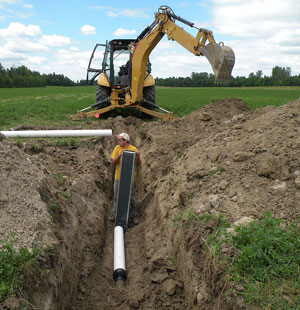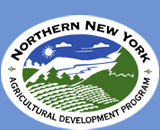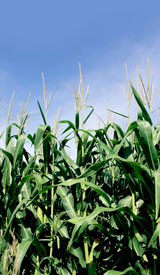April 21, 2010
Contacts: Larry D. Geohring, Cornell University, 607-255-2481; Eric
Young, Miner Institute, 518-846-7121 x113; also see list at end of
release
Northern NY Collaboration Enhancing On-Farm Water Quality
Control
A local, county and state partnership is evaluating options for Northern
New York farmers to enhance on-farm water quality protection measures.
Cornell University (Departments of Biological and Environmental
Engineering, Crop and Soil Sciences and Animal Science), W.H. Miner
Agricultural Research Institute, the Clinton County Soil and Water
Conservation District, and the New York State Department of
Environmental Conservation are collaborating to evaluate how soil
structure influences the transport of liquid manure into subsurface
drainage tiles.
The
Subsurface Drainage Water Management in NNY Project Leader Larry D.
Geohring, a senior extension associate with Cornell’s Department of
Biological and Environmental Engineering, says, “This is a combined
laboratory and field-based investigation into ways that we can enhance
on-farm water drainage management to prevent nutrient effluent from
reaching surrounding water sources.”
 The project team has installed flow control structures on the drainage
systems of two North Country farms – one in the Lake Champlain area, one
in the Great Lakes drainage basin.
The project team has installed flow control structures on the drainage
systems of two North Country farms – one in the Lake Champlain area, one
in the Great Lakes drainage basin.
The farms selected for the project are voluntary participants in the
Environmental Quality Incentives Program of the USDA’s Natural Resources
Conservation Service (NRCS). The program provides financial and
technical assistance to help farmers integrate agricultural production
and environmental quality as compatible goals.
Miner Institute Agronomist and project partner Eric Young says, “Tile
drainage is a critical system for many farms in Northern New York, for
example, Clinton County farms near Lake Champlain that use the
subsurface tile systems to enhance crop production, land use and natural
resource conservation.”
Geohring, a participant in a multi-state regional research and extension
committee working on drainage water management, says, “The results of
this work in Northern New York will immediately be of use not only to
farmers in the region, but will be applicable for farmers all around the
Great Lakes Basin from Michigan to Ontario, Canada.”
Holding Nutrients for Crop Use
“The control structures attached to the ends of tile lines on the farms
can control the level of the shallow ground water table using
‘mini-dams’ to hold the water back at various rates of flow. Slowing the
movement of subsurface water increases the time for soil or crops to
absorb nutrients,” Young says.
“Studies have shown that as much as 50 percent of nitrogen previously
lost from fields can be retained when the tile system is properly
managed. This research will evaluate the effectiveness of the system
with Northern New York soils,” Young adds.
The project has equipped eight tile lines in an 18-acre alfalfa field at
Miner Institute with the drainage control structures. The researchers
are monitoring the system for nitrogen and phosphorus retention before
and after manure application.
The Cornell University Soil and Water Lab is analyzing farm field soil
samples of different porosity for nitrogen and phosphorus leaching
potential.
Miner Institute Director of Lab Studies Stephen R. Kramer, says, “We
have established baseline chemistry and flow data for heavy clay
tile-drained fields growing corn and grass for comparison to data
collected with water control structures (valves) attached to the tile
outlets in the spring and fall of 2010. Overall, we hope to quantify the
small fraction of land-applied manure that is not absorbed by the field
at different times of the year.”
Final project results, expected in 2011, will be used to revise the
Drainage Guide for New York State published by the USDA Natural Resource
Conservation Service and Cornell University’s Department of Biological
and Environmental Engineering for use by farmers, landowners, drainage
material manufacturers, contractors, engineers, and agricultural
educators.
Watch for results of the Subsurface Drainage Water Management in NNY
Project to be posted online on the www.nnyagdev.org website of the
farmer-driven Northern New York Agricultural Development Program. # # #
Additional Contacts:
• Karl Czymmek, Cornell University Pro-Dairy Program/Animal Science
Senior Extension Associate, 607-255-4890
• Stephen Kramer, William H. Miner Agricultural Research Institute
Director of Laboratories, 518-846-7121 x127
• Jacqueline Lendrum, research scientist, New York State Department of
Environmental Conservation, 518-402-8118
• Stephen Mahoney, Clinton County Soil and Water Conservation District
Manager, 518-561-4616 x3
• Tammo S. Steenhuis, Cornell University Biological and Environmental
Engineering Professor, 607-255-2489
Additional information:
Cornell University Soil and Water Lab:
http://soilandwater.bee.cornell.edu/
Multi-State Research Committee: Drainage Design and Management Practices
To Improve Water Quality:
https://engineering.purdue.edu/SafeWater/NCR207



